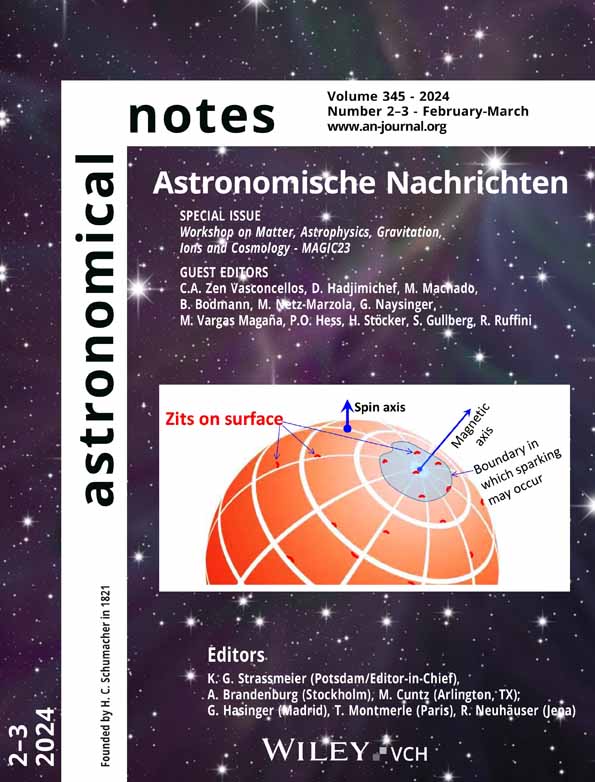Nuclear modification factor for quarkonium production in high energy proton-nucleus collisions within the parton saturation approach
Corresponding Author
Érison S. Rocha
HEP Phenomenology Group, Instituto de Física UFRGS, Rio Grande do Sul, Brazil
Correspondence
Érison S. Rocha and Magno V. T. Machado, HEP Phenomenology Group, Instituto de Física UFRGS, Rio Grande do Sul, Brazil.
Email: [email protected] and [email protected]
Search for more papers by this authorCorresponding Author
Magno V. T. Machado
HEP Phenomenology Group, Instituto de Física UFRGS, Rio Grande do Sul, Brazil
Correspondence
Érison S. Rocha and Magno V. T. Machado, HEP Phenomenology Group, Instituto de Física UFRGS, Rio Grande do Sul, Brazil.
Email: [email protected] and [email protected]
Search for more papers by this authorCorresponding Author
Érison S. Rocha
HEP Phenomenology Group, Instituto de Física UFRGS, Rio Grande do Sul, Brazil
Correspondence
Érison S. Rocha and Magno V. T. Machado, HEP Phenomenology Group, Instituto de Física UFRGS, Rio Grande do Sul, Brazil.
Email: [email protected] and [email protected]
Search for more papers by this authorCorresponding Author
Magno V. T. Machado
HEP Phenomenology Group, Instituto de Física UFRGS, Rio Grande do Sul, Brazil
Correspondence
Érison S. Rocha and Magno V. T. Machado, HEP Phenomenology Group, Instituto de Física UFRGS, Rio Grande do Sul, Brazil.
Email: [email protected] and [email protected]
Search for more papers by this authorAbstract
In this work, we analyze nuclear effects in the inclusive production of quarkonium in proton-nucleus collisions at high energy regime. A theoretical framework that includes initial state effects like nuclear shadowing and gluon density saturation is considered. Numerical results for nuclear modification factor, , as a function of meson rapidity in proton-nucleus collisions are presented. The parameter-free predictions are compared to the available data from the Large Hadron Collider. Discussion on the main theoretical uncertainties is made, with emphasis on the phenomenological models for the nuclear saturation scale.
REFERENCES
- Aaij, R., Abellán Beteta, C., Adeva, B., et al. 2014a, JHEP, 2, 72.
10.1007/JHEP02(2014)072 Google Scholar
- Aaij, R., Adeva, B., Adinolfi, M., et al. 2014b, JHEP, 7, 94.
10.1007/JHEP07(2014)094 Google Scholar
- Aaij, R., Adeva, B., Adinolfi, M., et al. 2017, Phys. Lett., B774, 159.
10.1016/j.physletb.2017.09.058 Google Scholar
- Aaij, R., Adeva, B., Adinolfi, M., et al. 2018, JHEP, 11, 194 (Erratum: JHEP02,093 (2020)).
- Abelev, B. B., Adam, J., Adamová, D., et al. 2014, JHEP, 2, 73.
- Acharya, S., Acosta, F. T.-., Adamová, D., et al. 2018, JHEP, 7, 160.
- Acharya, S., Adamová, D., Adler, A., et al. 2020, Phys. Lett. B, 806, 135486.
- Albacete, J. L., Arleo, F., Barnaföldi, G. G., et al. 2018, Nucl. Phys. A, 972, 18.
- Andronic, A., Arleo, F., Arnaldi, R., et al. 2016, Eur. Phys. J., C76(3), 107.
10.1140/epjc/s10052-015-3819-5 Google Scholar
- Armesto, N., Salgado, C. A., & Wiedemann, U. A. 2005, Phys. Rev. Lett., 94, 022002.
- Chen, A.-P., Ma, Y.-Q., & Zhang, H. 2022, Adv. High Energy Phys., 2022, 7475923.
10.1155/2022/7475923 Google Scholar
- Dominguez, F., Kharzeev, D. E., Levin, E. M., Mueller, A. H., & Tuchin, K. 2012, Phys. Lett., B710, 182.
10.1016/j.physletb.2012.02.068 Google Scholar
- Ducloué, B., Lappi, T., & Mäntysaari, H. 2015, Phys. Rev. D, 91(11), 114005.
10.1103/PhysRevD.91.114005 Google Scholar
- Dumitru, A., Hayashigaki, A., & Jalilian-Marian, J. 2006, Nucl. Phys. A, 770, 57.
- Golec-Biernat, K., & Sapeta, S. 2018, JHEP, 3, 102.
10.1007/JHEP03(2018)102 Google Scholar
- Golec-Biernat, K. J., & Wusthoff, M. 1998, Phys. Rev. D, 59, 014017.
- Golec-Biernat, K. J., & Wusthoff, M. 1999, Phys. Rev. D, 60, 114023.
- Iancu, E., Itakura, K., & McLerran, L. 2002, Nucl. Phys., A708, 327.
- Iancu, E., Itakura, K., & Munier, S. 2004, Phys. Lett. B, 590, 199.
- Jiang, Z.-F., Feng, S.-Q., Yin, Z., Shi, Y., & Yuan, X. 2014, Phys. Rev. C, 90(5), 054913.
- Kang, Z.-B., Ma, Y.-Q., & Venugopalan, R. 2014, JHEP, 1, 56.
10.1007/JHEP01(2014)056 Google Scholar
- Kharzeev, D., Levin, E., Nardi, M., & Tuchin, K. 2009, Phys. Rev. Lett., 102, 152301.
- Kharzeev, D., & Tuchin, K. 2006, Nucl. Phys., A770, 40.
- Kharzeev, D. E., Levin, E. M., & Tuchin, K. 2014, Nucl. Phys., A924, 47.
10.1016/j.nuclphysa.2014.01.006 Google Scholar
- Kowalski, H., Motyka, L., & Watt, G. 2006, Phys. Rev. D, 74, 074016.
- Ma, Y.-Q., Venugopalan, R., & Zhang, H.-F. 2015, Phys. Rev. D, 92, 071901.
10.1103/PhysRevD.92.071901 Google Scholar
- Marquet, C., Peschanski, R. B., & Soyez, G. 2007, Phys. Rev. D, 76, 034011.
10.1103/PhysRevD.76.034011 Google Scholar
- Rezaeian, A. H., & Schmidt, I. 2013, Phys. Rev., D88, 074016.
- Rothkopf, A. 2020, Phys. Rep., 858, 1.
- Stasto, A. M., Golec-Biernat, K. J., & Kwiecinski, J. 2001, Phys. Rev. Lett., 86, 596.
- Watanabe, K. 2017, Few Body Syst., 58, 134.
10.1007/s00601-017-1297-z Google Scholar
- Zhao, J., Zhou, K., Chen, S., & Zhuang, P. 2020, Prog. Part. Nucl. Phys., 114, 103801.




